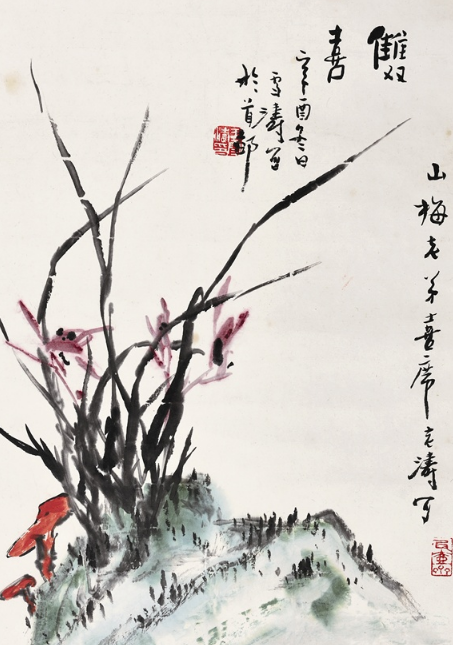大忌:忌无知
No. 1 taboo: taboo ignorance
懵懂无知是书画保藏与鉴赏的首要大忌,从古今许多藏家由于不懂书画而收到赝品或者被骗。发起藏者学习必定的书画史、书画理论以及去了解一些关于书画创作方面的常识。
Ignorance is the primary taboo in the preservation and appreciation of paintings and calligraphy. From ancient times till now, many Tibetans have been deceived or received fakes because they do not understand paintings and calligraphy. Initiate Tibetans to learn the necessary history of painting and calligraphy, painting and calligraphy theory, and to understand some common knowledge about painting and calligraphy creation.
一是是为了藏者能够把握书画作品的时代、流派、个人等风格特征,把握主动权是非常重要;二是也是为了在学习了解的过程中,培育或许加深藏者对书画作品的认识以及珍惜之情。
First, it is for the Tibetans to grasp the characteristics of the times, schools and individuals of painting and calligraphy works, and it is very important to grasp the initiative. Second, it is also for the purpose of cultivating or deepening the Tibetans'understanding and cherishing of painting and calligraphy works in the process of learning and understanding.
第二大忌:忌趋利悖德
Second taboo: avoid seeking profit and disobeying morality
保藏家的“德”是对艺术的酷爱,对发明艺术的艺术家的尊重,对判定家的尊重,对同好的尊重。这种酷爱和相互尊重通过持久的坚持和积淀会提高成为可贵的人格和品德。
The "virtue" of a collector is his love of art, his respect for the artists who invent art, his respect for the judges and his respect for the same good. This love and mutual respect will enhance the noble personality and moral character through perseverance and accumulation.
过于趋利有可能会使得藏家错失艺术品增值时期,过于趋利会有时使得藏家遮盖双眼,不能以久远目光去沉静观察艺术市场动态和艺术品的久远的增值空间,因而藏家忌过于趋利,应当秉持其“德”,对待艺术市场上的动态,沉静分析判别。
Over-profit-seeking may lead to the loss of the best value-added period of art works. Over-profit-seeking may sometimes make Tibetans cover their eyes, unable to observe the art market dynamics and the long-term value-added space of art works with a long-term vision. Therefore, Tibetans should not be too profitable, and should adhere to their "morality", calm down the dynamics of the art market, and calmly analyze and distinguish.
第三大忌:忌迷信“”
Third taboo: avoid superstition of "experts"
在藏者购入艺术品时,有时会由于缺乏经验或者是必定的鉴赏常识而向他人求助,因而会有时机碰到“”。
When Tibetans buy works of art, they sometimes turn to others for help because of lack of experience or certain appreciation knowledge, so they have the opportunity to meet "experts".
这些“”侃侃而谈,但其议论内容的真假需求藏家要有判别,不能由于一头热而迷信,这一起也要回到点处,要学习必定的艺术常识,要把握主动权,不能被盲目被迫地迷信“”。
These "experts" talk freely, but the authenticity of their content requires that the Tibetans have to be calm to distinguish, not superstitious because of a hot head. Together, they should return to the first point. They should learn certain common sense of art, grasp the initiative and not be blindly forced to superstition "experts".
当然,艺术判定这方面在缺乏经验时藏家需求找到真正拥有名贵经验的判定作为辅助意见,这是可取的做法,但切忌盲目被迫。

Of course, in the absence of experience in art judgment, Tibetans need to find judgement experts who really have valuable experience as assistant opinions. This is a desirable approach, but do not be blindly forced.
第四大忌:忌轻信著录
Fourth taboo: Don't trust the description
自古到今,上宫殿著录,下到民间书籍,都有收录过赝品假字画。古代制造假书画并再制造著录的明末上海人张泰阶,造的假书画包括有三国时期的吴国曹不兴、晋代顾恺之、隋代展子虔,以及宋元我们的伪作。
From ancient times to today, fake calligraphy and paintings have been included in the records of palaces and folk books. Zhang Taibian, a Shanghainese from the late Ming Dynasty who manufactured fake calligraphy and paintings and reproduced them in ancient times, made fake calligraphy and paintings including Cao Buxing of Wu State, Gu Kaizhi of Jin Dynasty, Zhanzipian of Sui Dynasty and famous fake works of Song and Yuan Dynasty.
并为兜售假书画而编进崇祯六年成书的《宝绘录》中。不仅如此,《石渠宝笈》中收录作品也并非全部是精品。这些例子就是提醒藏者别太轻信著录,著录可是辅助性东西,但不可以是首要判别的根据。
And for the sale of fake paintings and calligraphy and compiled into Chongzhen's six-year book "Bao Pi Lu". Not only that, but also the works included in Shiqu Baodu are not all excellent works. These examples are a reminder to Tibetans not to be too credulous about cataloguing. Cataloguing can be a supplementary thing, but it can not be the basis for the primary discrimination.
名人字画 张利力作聚宝盆山水画作品《天长地久流》
Celebrity calligraphy and painting Zhang Li's latest masterpiece Jubaoban Landscape Painting "Forever Flowing"
第五大忌:忌保存不善
Fifth taboo: avoid poor preservation
书画的保存比起其他来说难度较大,首要是由书画的材质相对脆弱性而决定,书画的保藏首要做好两方面,一个是注重装裱,一个是寄存要得当。
The preservation of painting and calligraphy is more difficult than others. It is mainly decided by the relative vulnerability of the material of painting and calligraphy. The preservation of painting and calligraphy should focus on two aspects, one is mounting, the other is proper storage.
